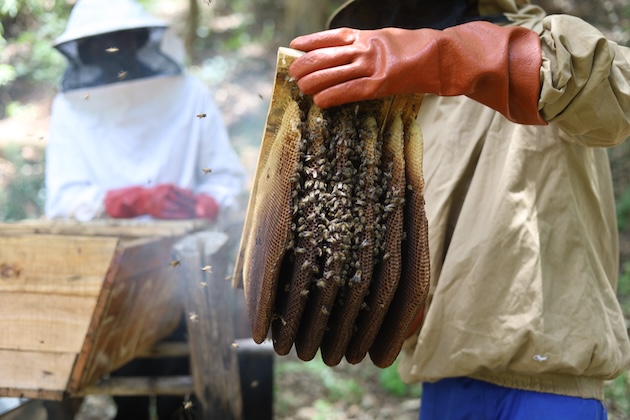
The Food and Agriculture Organization of the United Nations is training young beekeepers in Zimbabwe. Credit: Farai Shawn Matiashe/IPS
By Farai Shawn Matiashe
CHIMANIMANI, Zimbabwe, Mar 15 2024 – Honeybees quickly react with a sharp and loud buzz sound as beekeeper Tanyaradzwa Kanangira opens one of the wooden horizontal Kenyan top bar hives near a stream in a thick forest in Chimanimani, 412 kilometres from Zimbabwe’s capital, Harare.
The 26-year-old puffs some smoke, a safety measure, as he holds and inspects a honeycomb built from hexagons by the honey bees.
Many people in this part of the country rely on many forms of agriculture, from agroforestry and horticulture to crop production.
Nonetheless, with increasing floods and droughts as a result of climate change, both rainfed and irrigation agriculture have become somewhat unreliable, forcing farmers to diversify into other forms of farming like apiculture to sustain their livelihoods.
Kanangira is part of the 11 young people in Chimanimani, Manicaland Province, who have been supported by the United Nations’ Food and Agriculture Organization (FAO) with training in beekeeping as well as market linkages since June 2023.
“Factors to consider when establishing an apiary include the type of forage, such as flowers and herbs, warm climatic conditions, and water availability,” says Kanangira, wearing a white sting-proof bee suit.
Silence Dziwira, another beekeeper, says the use of chemicals by farmers is restricted in areas surrounding an apiary.
“We are planting bushy trees within the apiary and other different speeches. This helps in keeping the ground intact, preventing land degradation,” Dziwira, a mother of one, whose first harvest was late in 2023 and supplies the local market, tells IPS.
Beekeeping is not new in Zimbabwe, as it is part of the tradition and culture.
The knowledge has been passed from generation to generation.
But traditionally, people used log hives, which promoted deforestation.
In this day and age, farmers use modern-day hives like the Kenyan top bar hive used in Chimanimani, made out of sustainable materials.
An agroecology case study from the Alliance for Food Sovereignty Africa shows that there are more than 50,000 beekeepers in Zimbabwe today.
Patrice Talla, FAO representative in Zimbabwe, says they are supporting the beekeepers with capacity building on beekeeping, including hive making, honey harvesting and processing, and business management.
“Since 2021, FAO, under the Green Jobs project, has trained and equipped 300 youth in selected communities to increase employment amongst rural youths, enhance food security, reduce poverty, and support environmental sustainability,” he tells IPS.
To date, 319 beehives have been built to set up apiaries in different areas, according to Talla.
So far, out of 48 hives belonging to Kanangira and team, 13 have been colonised with Apis mellifera honey bees, the size of a paper clip.
Admire Munjuwanjuwa, a beekeeping expert based in Mutare, says beekeeping helps preserve forests.
“Beekeeping reduces deforestation because people cannot cut trees where there are bees; by so doing, trees will work as carbon sinks and reduce climate change,” he says.

A beekeeper holds a honeycomb in Chimanimani, Zimbabwe. Credit: Farai Shawn Matiashe/IPS
Robert Mutisi, another beekeeping expert, says apiaries protect the forests that act as bee habitats as well as sources of nectar.
“Beekeeping encourages farmers to plant trees and not cut trees indiscriminately. Beekeeping can act as a fire protection tool to guard against forest and vegetation destruction,” he says.
Kanangira says they have planted 3500 gum trees covering more than 2 hectares.
Three out of every four leading food crops for human consumption and more than a third of agricultural land worldwide depend in part on pollinators, according to the FAO.
Talla says bees are a barometer of the health of natural ecosystems and pollinators in forests.
“They play a major role in maintaining biodiversity, including wild, horticultural, and agricultural crops,” he says.
People consume honey as food, spreading it on bread and as a sweetener in tea.
Other byproducts of bees include beeswax, propolis, and pollen.
Traditionally, the beekeeping industry has been male-dominated but there has been growing interest in the sector by women building and running their apiaries across the country.
In Chimanimani, out of Kanangira’s team of 11 people, seven are women, showing that they are changing the narrative.
These beekeepers get monthly stipends from FAO.
“Earning a living from beekeeping makes me happy. As a woman, I did not think that I could venture into such a project as beekeeping,” says Dziwira, a mother of two.
“This initiative has made me realise my full potential as a woman and that I can successfully run a big project.”
Talla says revenue generated from the initiative will be saved and used to pay wages beyond the two-year support.
FAO’s beekeeping project, Green Jobs for Rural Youth Employment, funded by the Korea International Cooperation Agency (KOICA), is currently being implemented in three countries, including Zimbabwe, Sierra Leone, and Timor-Leste.
In Zimbabwe, the project is running in six districts, targeting young people.
Kanangira, who uses the money from beekeeping to look after his siblings, is planning to supply honey to markets in Harare.
“We plan to sell in large quantities to companies in Harare. To add value, we want to have a processing plant where we make things like toothpaste and floor polish using products from honeybees,” he says.
IPS UN Bureau Report

![It is critical that African scientists tackle African [...] <a class=](https://www.ipsnews.net/Library/2024/03/mdrtb-629x420-300x200.jpg) Read more »
Read more »